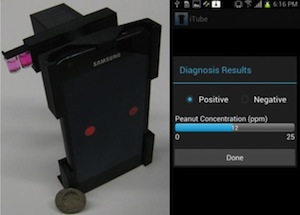As consumer food labeling distrust grows and food allergies become more prevalent, these researchers are developing tools that will bring a whole new level of transparency right to your smartphone.

#1: Lapka
Lapka is a “personal environment monitor” that allows people to collect, measure and analyze information about their environment via their smartphone. Lapka offers a series of sensor peripherals to measure organicity (how organic your food is), radiation, temperature, humidity and electromagnetic fields. Using the companion app, people are able to make sense of their findings through data visualizations and ratings. Lapka tests organicity of fruits and vegetables using a stainless steel probe, plugged into the phone via the headphone jack, to measure electrical conductivity. The level of conductivity relates to the concentration of nitrate ions from nitrogen-based fertilizers. Lapka is already available for purchase.
#2: iTube
Researchers from UCLA have developed
t used to determine the concentration of colored compounds in a solution. In as little as 20 minutes, the device and accompanying app can identify the presence of peanuts, almonds, eggs, gluten and hazelnuts. Aydogan Ozcan, a professor at UCLA, and his colleagues have successfully tested the technology on various types of commercially available cookies.
“This automated and cost-effective personalized food allergen testing tool running on cellphones can also permit uploading of test results to secure servers to create personal and/or public spatio-temporal allergen maps, which can be useful for public health in various settings,” write Ozcan and his colleagues in a paper published last month in the peer-reviewed journal Lab on a Chip.
#3 Rapid Testing of Food Quality
Germany’s Fraunhofer Institute is developing a miniature spectrometer that will allow consumers to determine the quality of food – if it's ripe or water-logged – before making the decision to buy it. The device uses near infrared technology to assess starch, protein, water, and fat content in food. Fraunhofer explains in a press release, “In the future, all you will need to do is hold your smartphone near the product in question, activate the corresponding app, choose the food type from the menu – e.g. “pear” – and straight away the device will make a recommendation: the fructose content of the pear is high, so buy it!” The device is currently being prototyped, but may be ready for market launch in three to five years, according to the press release.
-
BklynAllergyMom January 8, 2013 at 2:26 pmI'm loving the iTube already - need to expand the allergen list, but so far heading in the right direction!
-
food tech connect January 9, 2013 at 7:36 pmVery cool. Thank you for reporting back to us. What allergens are missing now?
-
Maya Joy November 26, 2013 at 2:18 pmplease could you post where to order this? Thanks!
-







